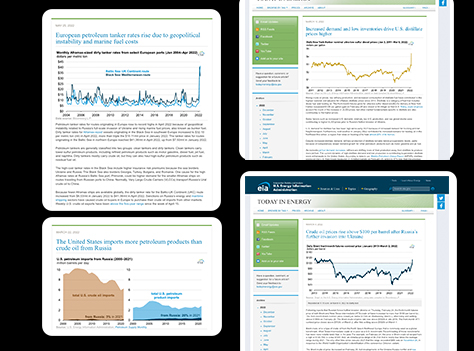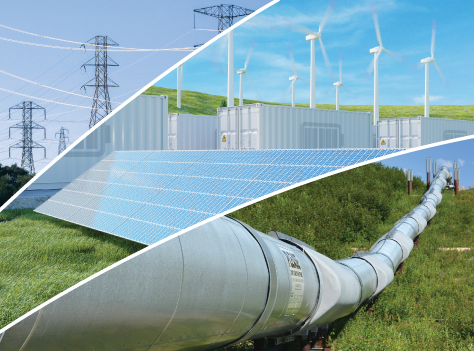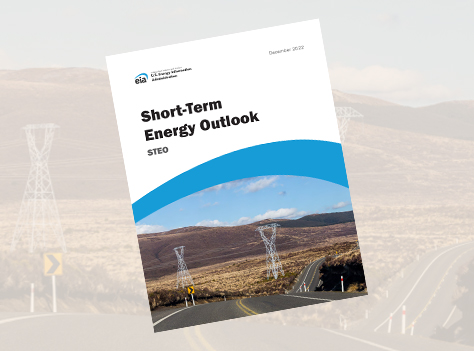

EIA’s top accomplishments of 2022
For EIA, 2022 was a year of notable accomplishments. We expanded our data coverage in key areas, provided timely energy analysis, and enhanced our forecasts and long-term projections, all amid rapidly changing energy markets. We also developed plans to further expand our coverage of the energy transition as outlined in the Bipartisan Infrastructure Law. Check out these highlights of EIA products and programs this year.

Released new residential energy consumption data
We released preliminary estimates from the 2020 Residential Energy Consumption Survey (RECS) on many topics, including residential lighting, electronics, appliances, fuels used, air conditioning, and household energy insecurity. The responding sample was the largest in the program’s history, at 18,496 households. This year was also the first time we released data for all 50 states and the District of Columbia. The survey also included new questions about smart home devices and electric vehicles. Because we also released our commercial building energy data this year, both surveys informed our analysis of energy consumption trends, including a Today in Energy article in which we compared small-scale solar use in residential homes and commercial buildings.

Analyzed the effects of Russia’s full-scale invasion of Ukraine
In response to Russia’s full-scale invasion of Ukraine and the resulting uncertainty in energy markets, we frequently updated our analysis of:
- Market changes in crude oil prices
- Distillate demand
- Tanker transportation rates
- U.S. petroleum imports

Added forecasts of renewable diesel and other biofuels to our Short-Term Energy Outlook
In our February Short-Term Energy Outlook (STEO), we introduced new forecasts for biodiesel, renewable diesel, and other biofuels in the United States, including production, consumption, and net imports minus exports. In previous STEO releases, we forecast biomass-based diesel consumption and combined all production and imports of biodiesel consumed in the United States with imported volumes of renewable diesel but not domestically produced renewable diesel. This new breakout provides a more detailed forecast for U.S. renewable diesel production and a more precise accounting of biomass-based diesel.

Added new data on crude oil and natural gas resource development and electric-generating capacity changes to our Monthly Energy Review
In our February Monthly Energy Review (MER), we introduced new crude oil and natural gas resource development data: rotary rigs in operation by trajectory and wells and footage drilled by trajectory. Not only does the new series provide more details on crude oil and natural gas rigs, wells, and footage drilled by trajectory, but it also highlights significant changes that can affect crude oil and natural gas markets.
In August, we added data on monthly changes in electric generating capacity by technology type to the MER. These data show the monthly decreases in coal capacity and the monthly increases in solar and wind capacity.

Published our Annual Energy Outlook
We released our Annual Energy Outlook 2022 (AEO2022) at a virtual public event hosted by the Bipartisan Policy Center. The annual report contains projections for the U.S. energy sectors and markets through 2050. Key takeaways from the AEO2022 include:
- Petroleum and natural gas remain the most-consumed sources of energy in the United States, but renewable energy is the fastest growing.
- Wind and solar incentives, along with falling technology costs, support competition with natural gas for electricity generation, and shares of coal and nuclear power decrease in the U.S. electricity mix.
- U.S. crude oil production reaches record highs, and natural gas production is increasingly driven by natural gas exports.
Following the release of the AEO2022 in March, we released five Issues in Focus articles to provide additional analysis:

Updated format of the Short-Term Energy Outlook
Beginning with our November Short-Term Energy Outlook (STEO), we introduced a new layout for the report that we believe will better highlight the most critical aspects of our monthly forecast. The key changes to the STEO format include:
- Two new tables in the overview section that show key forecast series and highlight revisions from previous forecasts
- Regrouped topic sections that provide a better balance across fuels, and an additional section that provides a deeper analysis of the electricity sector
- Additional data visualizations in the text portion of the STEO to provide more context to our analyses

Released new commercial building energy consumption data
We released preliminary consumption and expenditure estimates from the 2018 Commercial Buildings Energy Consumption Survey (CBECS). The newly released data tables provide preliminary information on energy consumption, expenditures, and intensity for major fuels, including electricity and natural gas, at the national and census-region levels. In addition, we prepared a collection of graphs that highlight key findings in the preliminary data. We also released data from our residential energy survey, which gave us the benefit of both surveys to inform our analysis, including a Today in Energy article in which we compared small-scale solar in commercial buildings and in residential homes.

Expanded the Petroleum Supply Monthly to include HGL inventories
In our March Petroleum Supply Monthly, we added inventories of hydrocarbon gas liquids (HGLs), which include volumes of ethane, propane, normal butane, isobutane, and natural gasoline at end-user storage facilities, as part of our reported wholesale terminal stocks. Starting in January 2021, we expanded the scope of our Monthly Bulk Terminal Report to include HGLs held by a sample of end users with at least 50,000 barrels of storage capacity and by smaller facilities that can ship products by pipeline, tanker, or barge.
This more comprehensive approach to inventory accounting also affects our estimate of product supplied, which we use as a proxy for consumption of petroleum products. Starting with the March 2022 Petroleum Supply Monthly, monthly reported HGL inventories in January 2022 and all subsequent months will reflect stocks at all bulk terminals, including end-user storage facilities meeting the reporting requirements.

Expanded the scope and timeliness of our international energy statistics
We improved our international energy data to better explain global energy production, infrastructure, and changing consumption patterns. We implemented a new imputation methodology to deliver updates to the International Energy Statistics (IES) database a full year sooner than our previous approach.
In addition, we extended our annual crude oil surplus capacity estimates for current OPEC members back to 1970. We also added estimates for non-OPEC countries (including both former members of OPEC as well as non-OPEC countries). This extended data series provides historical context for analyzing current market conditions.

Introduced estimates of hourly carbon dioxide emissions from electricity generation
In April, we launched a new dataset that estimates hourly CO2 emissions from electricity generation in the Lower 48 states. This dataset expands our Hourly Electric Grid Monitor, an interactive dashboard that provides a comprehensive overview of the U.S. electricity grid, including electricity generation by fuel source.
The new data help to illustrate how large-scale events, both expected and unexpected (such as major holidays or the COVID-19 pandemic), can affect electricity demand and can lead to changes in electricity usage and in patterns of associated CO2 emissions.

Tracked and reported energy disruptions caused by extreme weather and infrastructure closures
When several extreme weather events affected large areas of the country, we published real-time and retrospective analysis of the resulting energy disruptions. In addition, we directed readers to our tools that track the impacts of disruption events on energy infrastructure and markets:
- Before Hurricane Ian hit western Florida, we published a This Week in Petroleum article about the storm’s potential impact on gasoline supply and later published a Today in Energy article to update our readers with new information.
- We analyzed how an extreme heat wave in California during the week of September 4 changed the electricity generation mix and how Californians rapidly reduced electricity use on request.
- On June 8, a fire at Freeport LNG's natural gas liquefaction plant on the Gulf Coast in South Texas led to the full shutdown of the facility. In a Today in Energy article, we estimated how the shutdown would reduce total U.S. liquefied natural gas export capacity. We also explored the effects of the resulting decline in export capacity on the Henry Hub natural gas price.

Engaged a wide range of experts and stakeholders to improve the quality and value of our products
We strengthened relationships with stakeholders at the local, state, national, and global level through workshops, webcasts, and virtual events.
In March, our experts discussed the full findings of AEO2022 during a virtual event hosted by the Bipartisan Policy Center.
In June, we hosted two workshops where we invited energy experts to discuss ways we can improve our energy analysis in the International Energy Outlook (IEO). The Clean Power Investment Workshop, held on June 23, explored topics related to energy investment for a low-carbon future. We primarily focused on how electric power capacity around the world increasingly uses renewable resources for electricity generation. The Challenges in Modeling International Climate Policies Workshop, held on June 29, explored market forces that corporations face as they try to reduce their carbon emissions, as well as methods of modeling international climate policies.
In September, we hosted a webinar highlighting the results from the 2020 Residential Energy Consumption Survey. During the workshop, we discussed the latest data on all-electric homes, smart devices, air conditioning, and household energy insecurity.
In addition, we met with the American Statistical Association’s (ASA) Committee on Energy Statistics in September and hosted the annual Winter Fuels Outlook webinar in October.

Marked 25 years of the U.S. Crude Oil and Natural Gas Proved Reserves report
Since 1997, we’ve collected data about proved reserves of crude oil and natural gas in the United States. Proved reserves are estimated volumes of hydrocarbon resources that are recoverable, based on analysis of geologic and engineering data, under existing economic and operating conditions. We collect independently developed estimates of proved reserves from a sample of U.S. oil and natural gas field operators and then use this sample to further estimate the portion of proved reserves from operators who do not report. Our respondents represent about 90% of proved reserves of oil and natural gas nationally. In addition to national estimates, we also develop estimates by state and some state subdivisions.

